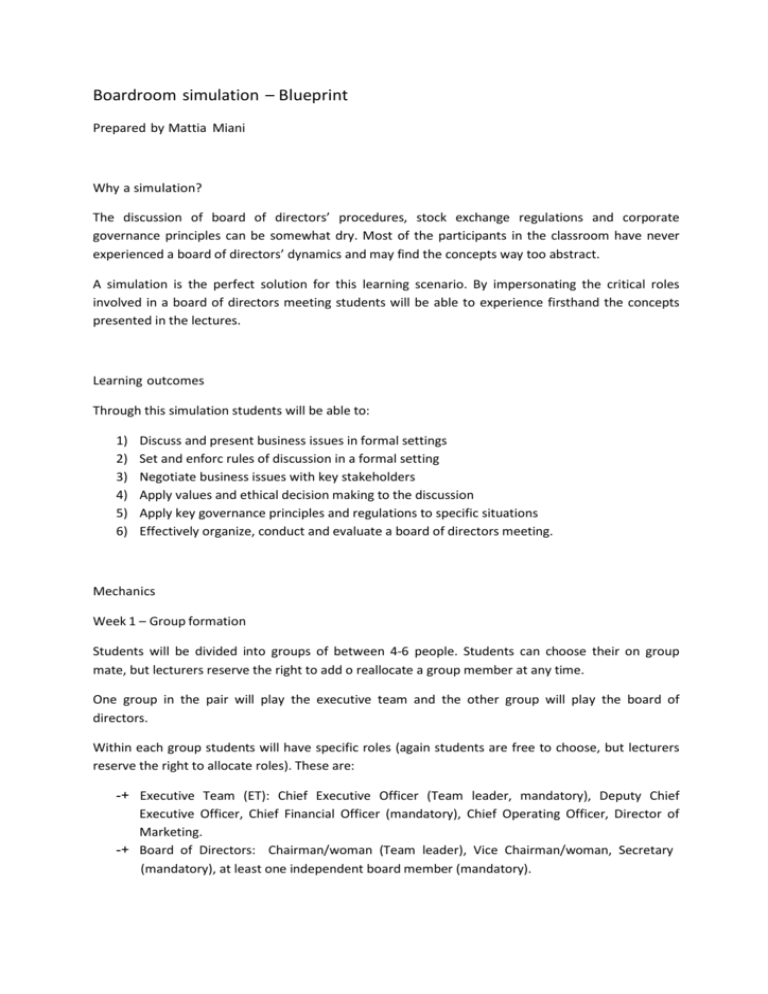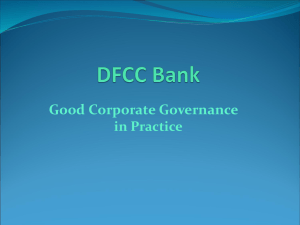Microsoft Word - boardroomsimulationblueprint2
advertisement

Boardroom simulation – Blueprint Prepared by Mattia Miani Why a simulation? The discussion of board of directors’ procedures, stock exchange regulations and corporate governance principles can be somewhat dry. Most of the participants in the classroom have never experienced a board of directors’ dynamics and may find the concepts way too abstract. A simulation is the perfect solution for this learning scenario. By impersonating the critical roles involved in a board of directors meeting students will be able to experience firsthand the concepts presented in the lectures. Learning outcomes Through this simulation students will be able to: 1) 2) 3) 4) 5) 6) Discuss and present business issues in formal settings Set and enforc rules of discussion in a formal setting Negotiate business issues with key stakeholders Apply values and ethical decision making to the discussion Apply key governance principles and regulations to specific situations Effectively organize, conduct and evaluate a board of directors meeting. Mechanics Week 1 – Group formation Students will be divided into groups of between 4-6 people. Students can choose their on group mate, but lecturers reserve the right to add o reallocate a group member at any time. One group in the pair will play the executive team and the other group will play the board of directors. Within each group students will have specific roles (again students are free to choose, but lecturers reserve the right to allocate roles). These are: -+ Executive Team (ET): Chief Executive Officer (Team leader, mandatory), Deputy Chief Executive Officer, Chief Financial Officer (mandatory), Chief Operating Officer, Director of Marketing. -+ Board of Directors: Chairman/woman (Team leader), Vice Chairman/woman, Secretary (mandatory), at least one independent board member (mandatory). Students will be given a company scenario detailing a number of business issues that must be addressed in the simulation. Week 2-4 – Procedure definition In this week BD defines its own procedures referring to ASX Corporate Governance guidelines and local regulations. The procedures must just explain how the board meeting are to be conducted. In particular this document should answer the following questions: 1) 2) 3) 4) 5) 6) 7) When and where the does the board meet? How is the agenda formulated? Who can propose items to be included? What kind of documentation must be provided to board members? What is the timing to call a board meeting? How are minutes kept and approved? What kind of voting procedure is in place? Who can be invited to attend in addition to board members? In defining these procedures students do not have to address broader governance issues that will be discussed in the meeting after the presentation by the ET. The ET will work on a presentation detailing the corporate governance reforms needed for the company. Again, ASX guidelines, OECD principles and local regulations will be the reference. The presentation should answer, among the others, the following questions: 1) 2) 3) 4) 5) What kind of governance system is needed to be ready to be listed? What kind of disclosure procedures must be put in place? How board members and executives must be chosen and compensated? How the board of directors should be organized? What will be the interaction between the board and the executive team? BD and ET may interact to identify additional issues to be discussed in the upcoming board of directors meeting. Week 4: Board meeting agenda and invitations BD issues official agenda and invitation of board meeting. Week 5-6: Board meeting(s) In this session, the members of each board of directors group will meet together with their other group members and invite the appropriate pairing executive team to present to the board of directors on key issues. Then the board of directors group will carry out discussion and formulate decisions. After the meeting BD will circulate minutes of the meeting and take any necessary follow up as established in his procedures. Week 7: Debrief and Individual reflections By the end of week 7, students will submit an individual 300 word reflection on the experience to their teacher. Follow up The board of directors group may be recalled by the teacher to discuss new issues in the second part of the course. Grading The assignment is worth up to 30 raw marks out of your total assessment. You will be given a mark out of 100 which will then be converted to a mark out of 30. 40%: quality of documents prepared (meeting procedure, agenda invitation and minutes prepared by board of directors group, written documentation of presentation and correspondence prepared by executive group) and its relevance to the case premises and official regulations. All written documents should be professionally presented and submitted to your teacher electronically in a single batch by the end of week 5 or 6 (depending on when the board will meet). 40%: presentations (Executive group) and subsequent discussion (board of directors). Each group member is expected to contribute to these parts of the assessment, which will be observed by your teacher. 20%: individual reflection to be submitted to your teacher by the end of week 7 on TII. Attached documents • • • • • • • • • ASX Corporate Governance Principles and Recommendations with 2010 Amendments OECD Principles of Corporate Governance HCMC Stock Exchange listing rules overview Circular on Disclosure of information on the securities market Law on Enterprises Law on Securities Decree 102/2010 Detailing a Number of Articles Of the Law on Enterprises The language of directorship. A dictionary of terms Guidelines for Conducting a Meeting of the Board of Directors or a Meeting of Shareholders in Vietnam (by Mekong Capital, not an official document) For VN corporate governance you can also reference to IFC, Corporate Governance Manual (Vietnam), second edition, IFC, Hanoi, 2010







